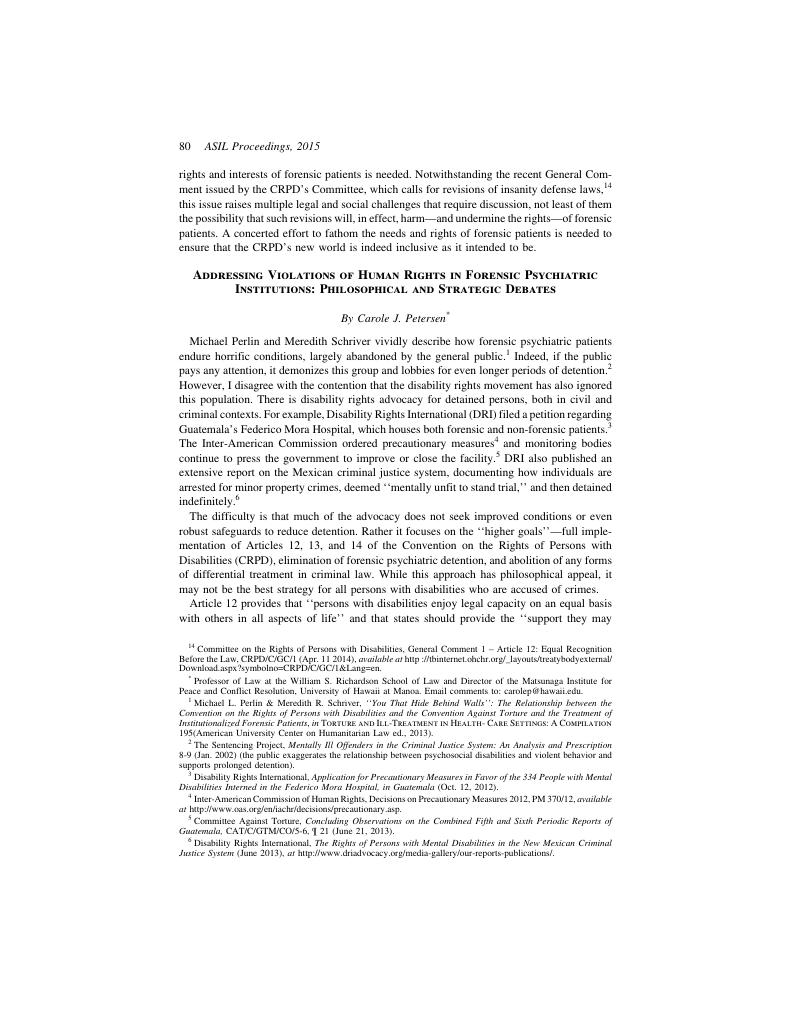Published online by Cambridge University Press: 20 January 2017

1 Perlin, Michael L. & Schriver, Meredith R., “You That Hide Behind Walls”: The Relationship between the Convention on the Rights of Persons with Disabilities and the Convention Against Torture and the Treatment of Institutionalized Forensic Patients, in Torture and Ill-Treatment in Health-Care Settings: A Compilation 195 (American University Center on Humanitarian Law ed., 2013)Google Scholar.
2 The Sentencing Project, Mentally Ill Offenders in the Criminal Justice System: An Analysis and Prescription 8-9 (Jan. 2002) (the public exaggerates the relationship between psychosocial disabilities and violent behavior and supports prolonged detention).
3 Disability Rights International, Application for Precautionary Measures in Favor of the 334 People with Mental Disabilities Interned in the Federico Mora Hospital, in Guatemala (Oct. 12, 2012).
4 Inter-American Commission of Human Rights, Decisions on Precautionary Measures 2012, PM 370/12, available at http://www.oas.org/en/iachr/decisions/precautionary.asp.
5 Committee Against Torture, Concluding Observations on the Combined Fifth and Sixth Periodic Reports of Guatemala, CAT/C/GTM/CO/5-6, ¶ 21 (June 21, 2013).
6 Disability Rights International, The Rights of Persons with Mental Disabilities in the New Mexican Criminal Justice System (June 2013), at http://www.driadvocacy.org/media-gallery/our-reports-publications/.
7 UN High Commissioner for Human Rights, Annual Report: Thematic Study on Enhancing Awareness and Understanding of the Convention on the Rights of Persons with Disabilities, A/HRC/10/48, ¶ 42 (Jan. 2009).
8 Id. ¶ 47.
9 Compulsory treatment is highly controversial. See, e.g., Szmukler, George, Daw, Rowena & Callard, Felicity, Mental Health Law and the UN Convention on the Rights of Persons with Disabilities, 37 Int’l J. L. & Psychiatry 245 (2014)CrossRefGoogle ScholarPubMed. Compulsory medical treatment can be a form of torture in certain circumstances, which is prohibited as a jus cogens norm of customary international law, as well as by the CRPD, the CAT, and the International Covenant on Civil and Political Rights.
10 Committee on the Rights of Persons with Disabilities, General Comment 1 – Article 12: Equal Recognition Before the Law, CRPD/C/GC/1, (Apr. 11 2014), available at http://tbinternet.ohchr.org/_layouts/treatybodyexternal/Download.aspx?symbolno=CRPD/C/GC/1&Lang=en.
11 Id. ¶¶ 20-21.
12 Committee on the Rights of Persons with Disabilities, Statement on Article 14 of the Convention on the Rights of Persons with Disabilities (Sept. 2014), available at http://www.ohchr.org/EN/NewsEvents/Pages/DisplayNews.aspx?NewsID=15183&LangID=E. The Committee has also criticized individual governments for maintaining procedures that permit a defendant to be deemed “unfit” to stand trial and subsequently detained. See, e.g., Committee on the Rights of Persons with Disabilities, Concluding Observations on the Initial Report of New Zealand, CRPD/C/NZL/CO/1, ¶ 33 (Oct. 31, 2014).
13 SC v United Kingdom, 40 Eur. Ct. H.R. 10 (2005).
14 UN High Commissioner for Human Rights, Annual Report: Thematic Study on Enhancing Awareness and Understanding of the Convention on the Rights of Persons with Disabilities, A/HRC/10/48, ¶ 47 (Jan. 2009).
15 Minkowitz, Tina, Rethinking Criminal Responsibility from a Critical Disability Perspective: The Abolition of the Insanity/Incapacity Acquittals and Unfitness to Plead and Beyond, 24 Griffith L. Rev. 434 (2014)CrossRefGoogle Scholar.
16 Christopher Slobogin, Minding Justice: Laws That Deprive People with Mental Disability of Life and Liberty (2006), and Christopher Slobogin, Eliminating Mental Disability as a Legal Criterion in Deprivation of Liberty Cases: The Impact of the Convention on the Rights of Persons with Disability on the Insanity Defense, Civil Commitment, and Competency Law, Vanderbilt Pub. L. Research Paper No. 14-23, available at http://papers.ssrn.com/sol3/papers.cfm?abstract_id=2461279.
17 Law Commission (UK), Unfitness to Plead (consultation documents available at http://lawcommission.justice.gov.uk/areas/unfitness-to-plead.htm).
18 Australian Law Reform Commission, Equality, Capacity and Disability in Commonwealth Laws (ALRC Report 124), Ch. 7: Access to Justice: Eligibility to Stand Trial, at https://www.alrc.gov.au/publications/eligibility-stand-trial.
19 Australian law reform is particularly important as it tends to influence law reform in the Asia-Pacific region, where disability discrimination is severe. See Petersen, Carole J., The Convention on the Rights of Persons with Disabilities: Using International Law to Promote Social and Economic Development in the Asia Pacific, 35 U. Haw. L. Rev. 831 (2013)Google Scholar. For example, Australian law served as a model for Hong Kong’s Disability Discrimination Ordinance, which is probably the strongest such law in East Asia. See Petersen, Carole J., A Progressive Law with Weak Enforcement? An Empirical Study of Hong Kong’s Disability Law, 25 Disability Stud. Q. 1 (2005)Google Scholar.
20 UN Human Rights Committee, General Comment No. 35 - Article 9 (Liberty and Security of Person), CCPR/C/GC/35, ¶ 19 (Dec. 16, 2014), available at http://tbinternet.ohchr.org/_layouts/treatybodyexternal/TBSearch.aspx?Lang=en&TreatyID=8&DocTypeID=11 (emphasis added).
21 See World Network of Users and Survivors of Psychiatry (WNUSP) and International Disability Alliance (IDA), Human Rights Committee Disappoints Disability Community; Still Tolerates Mental Health Detention, Press Release (July 24, 2014), available at https://dk-media.s3.amazonaws.com/AA/AG/chrusp-biz/downloads/290157/WNUSPIDAresponsepara19.pdf.
22 UN Human Rights Council, Report of the Working Group on Arbitrary Detention – A Compilation of National, Regional, and International Laws, Regulations and Practices on the Right to Challenge the Lawfulness of Detention Before Court, A/HRC/27/47, ¶¶ 46-49 (June 30, 2014), available at http://www.ohchr.org/EN/Issues/Detention/Pages/Annual.aspx.